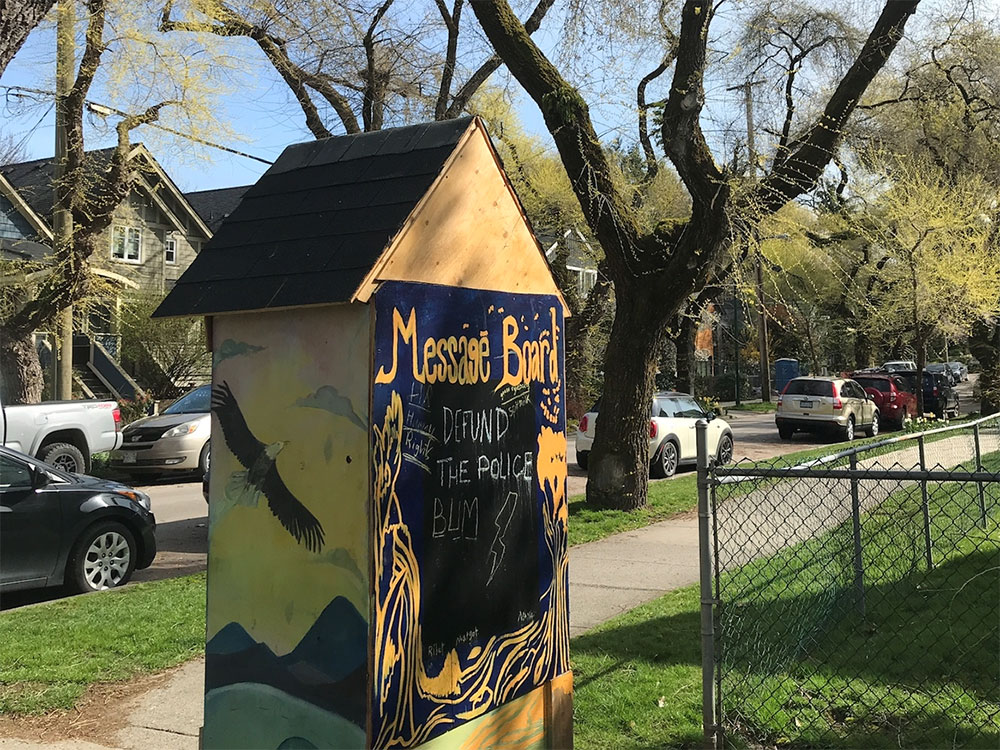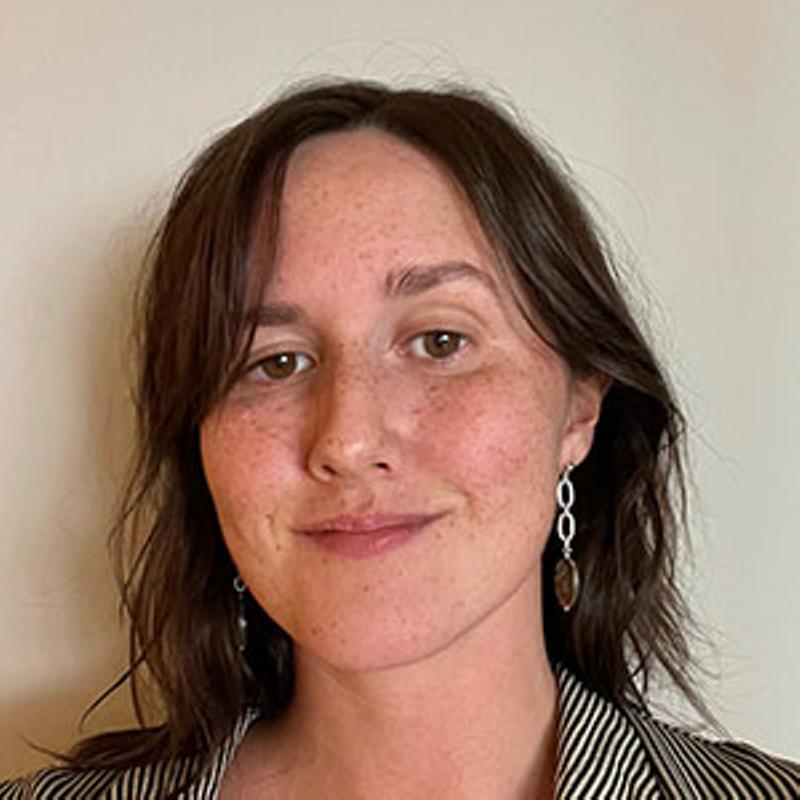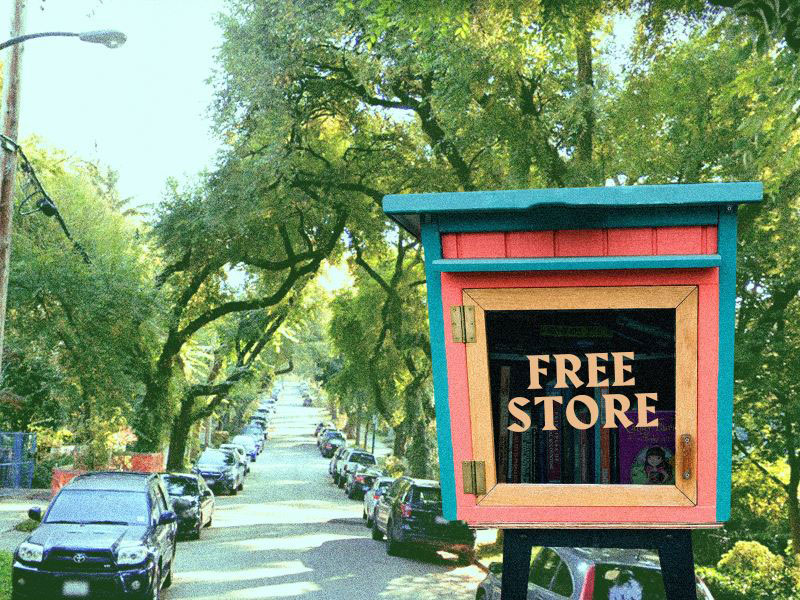You might not have heard of free stores, but if you live in Vancouver, you’ve likely seen one. They can be found all over the city, usually in residential areas, and serve as sharing points for things like clothing, food and books. Often these small spaces — unassumingly blending into the streets they call home — are managed by locals and built of scavenged materials.
A free store, in the most basic sense, is a place to put things you no longer need so that others can have them. One used to stand in the front yard of the East Sixth Avenue house where I live. It was less a store and more a plywood cupboard with a little peaked roof and an eagle, among other images, painted on the side. It was, as my friend who built it in April 2020 put it, “an experimental inquiry into the role of the artist as public service provider.” And I had a special relationship to that experiment.
Until, that is, someone set fire to it on October of last year.
My partner had managed the free store for just under a year, and I’d taken on the role alone just a little over a month before the blaze.
Managing the free store was straightforward. We organized donations and made sure that things were tidy enough so that our landlord wouldn’t take issue with it, because he often did. My partner was especially good at this job, and he made sorting and reorganizing a part of his morning routine. The idea was for it to be a place to visit that got people curious, and not just a pile of stuff on the side of the road.
My partner enjoyed watching from the window as people walked up to the free store, sometimes by accident and other times intentionally. He took pleasure in seeing them feel through the clothing, sift through the tall stack of books, or just smile. One day, he saw someone with a visible limp pick up a leg brace that had been there for several weeks, try it on and take it home.
And then came the text from my landlord that the free store had been set on fire overnight. It was first thing in the morning, and I remember feeling stunned — afraid, even. “You will need to clean up the remains of the fire by the end of the day,” his message said. Our free store was gone.
It turns out I had heard it burn from my bedroom window, but, half asleep, had assumed the crackles were just rain.
By the time my upstairs neighbour woke up at around 6:30 a.m., the fire department was already there to extinguish the flames that not only destroyed the structure but nearly set alight a nearby lilac tree. A police officer arrived to ask my neighbour questions about who might have started the fire, and if they had seen anything. No one had, so a report was filed and that was that.
Initially, I assumed the worst — that it had been one of our wealthier neighbours, or the man next door who’d complained about the free store a few times. For a moment, I even suspected our landlord, whose texts about the free store had become increasingly demanding in the preceding weeks. If something didn’t fit neatly inside of it, I’d get a text in a matter of hours.
I wondered what message the fire setter meant to deliver. I took it that the free store, with all it had to offer, was too generous for this place. It was too much in violation of how we are expected to get our needs met through earning and spending. It didn’t ask anything of us, and for this reason, it was unacceptable.
I created these motivations to fit the description of the culprit I had in my head — but in reality, it could have been anyone. The fire could have been set just for twisted fun.
Regardless of what happened to it, our block now felt unmoored and more at odds with itself. When I looked around that first week, it was hard to not see fires everywhere.
We lost more than just things
Later in the day after the free store burned, my partner took to sorting the debris into bags. His grief was quiet but pronounced. People who happened upon us cleaning up shared their stories about the store.
One man slowed down in his car to chat, visibly in tears about what had happened. His wife had been sourcing children’s clothing from the free store to send to the Caribbean island nation of St. Lucia. They were long-time renters on the block, now experiencing issues with their landlord and finding it hard to coexist with changes happening in the area.
Another neighbourhood person, a daily presence outside the nearby JJ Bean who keeps their finger on this block’s pulse, told us they were sad to see a piece of something good die.

The store meant something different to each person. This was a big part of why it mattered. Sometimes it meant enough dry food for dinner, and other times, it meant a new pot or pan.
My partner and I were surprised by some of the items that would disappear — small scraps of fabric, ancient magazines, miscellaneous plastic parts. The rule quickly became to keep anything that wasn’t mouldy, rotten or obviously garbage. I scored a few things from the store myself, my favourite being a weathered pair of hiking boots that still give me blisters.
Since the fire, I’ve realized it wasn’t just the items in it that were displaced. We also lost the experience of interacting with them.
Which raises the obvious question. Why not just build another free store where the original stood? I don’t expect that will happen. My landlord doesn’t want one and I’m tired of picking battles with him. In fact, the entire experience seems to speak to the larger story pitting grassroots creativity against moneyed forces of transformation unfolding in my neighbourhood.
When I moved back to Vancouver after some time in the Interior, I was excited to live in Grandview-Woodland, and still am. There is a spirit to this part of the city. But there is also a deep and building tension driven by gentrification.
The average price of a home here is $1,470,393. There are slumlords making upwards of $8,000 per month on multi-unit houses like the one I live in. New flashy restaurants often threaten local favourites, and recently, the local JJ Bean put up a fence around a longtime public hangout spot to better “honour its customers.” These facts paint a bleak picture. But on a sunny day, you can still count on the regular corner crew to play reggae, as if to draw you out into a world of feeling, of details.
When you enter this world, there is always a lot to notice. On the same fence around JJ Bean’s new patio, next to the sign about honouring customers, it now also reads in Sharpie that “fences are how you know the land is stolen.” A few feet away, in fluorescent orange marking paint, the sidewalk reminds us of where we are, that this land is unceded.
Our block is another example of how resistance and joy can go hand in hand. Sometimes, one of my favourite local corner dwellers will kick his feet up on his motorcycle to watch Netflix all afternoon. Once, an elderly couple set up a table on the patch of grass between their car and the sidewalk to have a picnic, share beers and listen to David Bowie. Our free store fit in nicely.
I chose this area because the suite my roommates and I share is affordable enough, close to a SkyTrain, and in an interesting part of the city. And I have no illusions about my own role in the forces at play here. I’m a white settler, university-educated and young. My being here is inextricable from the long wave of gentrification closing in on Commercial Drive, displacing Indigenous peoples, elderly immigrant folks, unhoused folks, punk and queer communities.
This has made me see the fire that swept away our free store through a sharper lens. I, too, have the potential to threaten the spaces these communities have built for themselves. Which means that the room I take up here comes with a responsibility. It means that if I am to become a part of what’s here, I have to actively centre what already exists. I have to consult with real connections to this place and look at my world honestly. Otherwise, gentrification will persist, and make sure that I cannot.
Here then is what I deeply value about my neighbourhood and will work to protect. For many folks, the Drive is a safe zone to be weird. Free stores are also weird in that they offer a low-barrier opportunity to take what you need and to feed yourself. There are no lineups or questions asked. They are circular, focusing on what can be offered from what we already have.
And because they often do pop out against their backdrop, they also encourage discussions about what else exists here and how it is different from those million-dollar homes.
Maybe they highlight the difference between living in a place and living in a community. Or the line between where Grandview-Woodland is a gentrified neighbourhood and where it is still a community of people that are invested in each other. A place where groups busk on every third corner, people spend days and days under the same awning and friendships grow on the sidewalks through shared weed and laughs. A place of overlapping realities.
The free store illuminated this multiplicity. It did so by creating a meeting space where not only our things, but our wants and needs could be shared. There is likely much we can do to make free stores more personal, intentional and impactful. But they might be a starting tether-point in our own relationship with the people we live next to and to the possibility of a more equitable future here.
Now it is summer. The music is back and the crowd on the corner has multiplied. The lilac tree that once cast shade on our little free store bloomed this spring in its same shade of purple. There is a seed where something has burned. ![]()
Read more: Local Economy
















Tyee Commenting Guidelines
Comments that violate guidelines risk being deleted, and violations may result in a temporary or permanent user ban. Maintain the spirit of good conversation to stay in the discussion.
*Please note The Tyee is not a forum for spreading misinformation about COVID-19, denying its existence or minimizing its risk to public health.
Do:
Do not: